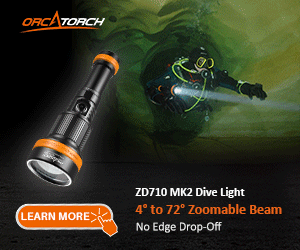So I'm back from my trip.
Check out some of pics I took in New Zealand. I did two dives at the Poor Knights Islands off the north island there. The 770 is only rated to 10 meters without a housing, and since the first dive we'd be down around 25 meters, I only took it on the second dive. I took it down as deep as 13.3 meters (around 45 feet, whereas it's rated to 33 ft) with no problem. When you get down to about 8 meters, a red text message flashes on the screen "warning: depth", but doesn't prevent you from taking a picture. It was neat to be able to take it down without a housing, but I think I'll get a housing for it in the future so I won't have to worry about the depth.
As far as its performance: the 770 does pretty well for a compact digital camera. It's no SLR, but the majority of my underwater and regular above water pictures turned out pretty good. There were certainly times I wish I had more than a 3x zoom, and there were also times when the camera seemed to have trouble autofocusing on the right thing, but I didn't think those problems were any worse for this camera than for other compact digicams I've used. re-taking the picture with a boosted iso level really helps in low light conditions, and the display interface is pretty easy to get used to.
Under water, obviously the clearer the water and the closer you get to the subject, the better. I found the underwater macro to be fantastic for close up shots of nudibranchs and eels. The other two modes made for underwater shots: underwater wide 1 (for wide angle shots like coral reefs) and 2 (for fish swimming by) were ok, but the seemed about the same as just leaving the camera on the automatic "P" mode with the flash turned off. Again, to improve the quality or reduce blurriness of low-light pictures, increasing the iso manually worked best for me. And boosting the iso is easier and quicker on the camera's interface than switching modes, which requires like 5 or 6 button presses.
I didn't have the occasion to test the "shockproof" claim, and I don't intend to purposefully drop the camera, so that claim will have to remain untested by me. But I did use the camera in Antarctica at temperatures around 0 deg F (colder with wind chill), and it seemed to work just fine. I did notice that if I was holding it out in those temperatures for a long time (say, a minute or more) the low battery indicator would come on. But then after keeping the camera in my warm pocket for a while, the battery would appear back at a fuller charge. I think that's just due to chemical batteries being less effective at low temperatures, which is a problem across the board. Anyway, the low temps didn't hinder my picture taking ability at all, but I'm not convinced there would have been more problems with non "freezeproof" cameras either.
I've posted some of my pictures from New Zealand on flickr, and the Antarctica ones should be up sometime this weekend.
New Zealand - a photoset on Flickr




